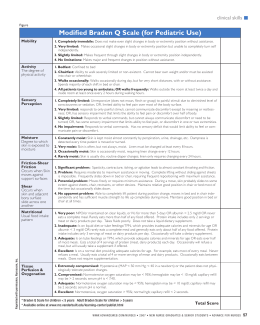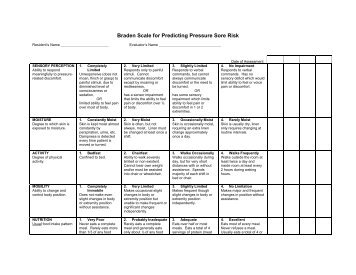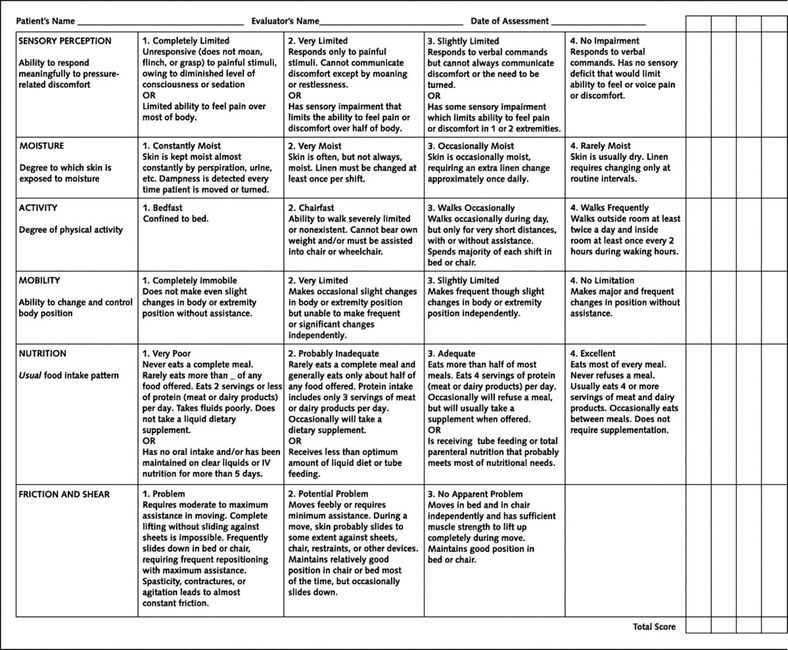The Braden Scale is a widely used assessment tool in the field of nursing to determine a patient’s risk for developing pressure ulcers, also known as bedsores. It is an essential tool that helps healthcare professionals identify patients who require additional preventive measures to avoid the development of these painful and potentially serious wounds.
Braden Scale Overview
 The Braden Scale evaluates six different areas of assessment to determine the overall risk for developing pressure ulcers:
The Braden Scale evaluates six different areas of assessment to determine the overall risk for developing pressure ulcers:
- Sensory perception
- Moisture
- Activity
- Mobility
- Nutrition
- Friciton and shear
Each area is assigned a score ranging from 1 to 4, with 1 being the highest risk and 4 being the lowest risk. The individual scores are then added together to obtain the total Braden Scale score, which ranges from 6 to 23.
Braden Scale Sore Risk
This image displays the Braden Scale Sore Risk #2294-2, which is a specific tool used to assess a patient’s risk for developing pressure ulcers. It provides healthcare professionals with a visual representation of the scale, allowing for efficient and accurate assessments.
Neonatal/Infant Braden Q Scale
 The Neonatal/Infant Braden Q Scale is designed specifically for neonates and infants to assess their risk of developing pressure ulcers. It takes into consideration factors such as skin integrity, infant behavior, and mobility to determine the risk level.
The Neonatal/Infant Braden Q Scale is designed specifically for neonates and infants to assess their risk of developing pressure ulcers. It takes into consideration factors such as skin integrity, infant behavior, and mobility to determine the risk level.
Braden Scale for Eating and Pain

Braden Scale in Nursing
 The Braden Scale is a vital tool in nursing practice and is frequently used by healthcare professionals to assess patients for their risk of developing pressure ulcers. Nurses rely on this scale to determine the appropriate preventive interventions for their patients, such as repositioning, ensuring adequate nutrition, and managing moisture levels.
The Braden Scale is a vital tool in nursing practice and is frequently used by healthcare professionals to assess patients for their risk of developing pressure ulcers. Nurses rely on this scale to determine the appropriate preventive interventions for their patients, such as repositioning, ensuring adequate nutrition, and managing moisture levels.
Braden q Assessment
 This image depicts the Braden q assessment, which is an updated version of the Braden Scale that includes additional factors that can influence the risk of pressure ulcer development. It provides a comprehensive evaluation of a patient’s risk and aids healthcare professionals in implementing effective preventive strategies.
This image depicts the Braden q assessment, which is an updated version of the Braden Scale that includes additional factors that can influence the risk of pressure ulcer development. It provides a comprehensive evaluation of a patient’s risk and aids healthcare professionals in implementing effective preventive strategies.
Braden q Scale

Importance of the Braden Scale
 The Braden Scale is of utmost importance in the field of nursing as it enables healthcare professionals to identify patients at high risk for developing pressure ulcers. By implementing appropriate prevention strategies based on the Braden Scale scores, nurses can significantly reduce the incidence of these debilitating wounds and improve patient outcomes.
The Braden Scale is of utmost importance in the field of nursing as it enables healthcare professionals to identify patients at high risk for developing pressure ulcers. By implementing appropriate prevention strategies based on the Braden Scale scores, nurses can significantly reduce the incidence of these debilitating wounds and improve patient outcomes.
Braden Scale PDF
 This image showcases the Braden Scale in PDF format, which allows for easy access and dissemination of this valuable assessment tool. The PDF format ensures that healthcare professionals can utilize the Braden Scale in electronic or printed form, making it accessible in various healthcare settings.
This image showcases the Braden Scale in PDF format, which allows for easy access and dissemination of this valuable assessment tool. The PDF format ensures that healthcare professionals can utilize the Braden Scale in electronic or printed form, making it accessible in various healthcare settings.
Braden Risk Scoring
 This image highlights the importance of Braden Risk Scoring, which is a fundamental aspect of assessing a patient’s risk for developing pressure ulcers. By accurately scoring the Braden Scale, healthcare professionals can tailor preventive interventions to the specific needs of each patient, ultimately reducing the occurrence of pressure ulcers.
This image highlights the importance of Braden Risk Scoring, which is a fundamental aspect of assessing a patient’s risk for developing pressure ulcers. By accurately scoring the Braden Scale, healthcare professionals can tailor preventive interventions to the specific needs of each patient, ultimately reducing the occurrence of pressure ulcers.
In conclusion, the Braden Scale is a critical tool in nursing that aids in identifying patients who are at a higher risk for developing pressure ulcers. Through a thorough assessment of various factors, healthcare professionals can implement appropriate preventive measures to safeguard the skin integrity of their patients. The use of the Braden Scale promotes better patient outcomes and enhances the quality of care provided by healthcare professionals.